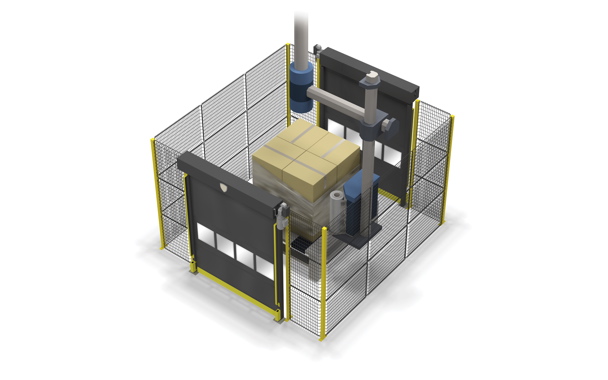
Protecting workers from automated machine operations
By John Ritter, Rite-Hite Doors product manager
Automation General Robotics Rite-Hite Robotics Industrial Association safe automated machine operations Worker SafetyRite-Hite Doors product some keen worker safety advice.
In the ever-evolving industrial world, new technologies are constantly putting old safety rules out of date. Even old-fashioned processes like stretchwrapping have become more technologically advanced and are often automated today. Protecting workers from the potential dangers associated with these operations is not only a best practice, it’s becoming law.
One of the best ways to ensure a safe work environment is by conducting a thorough risk assessment at regular intervals and whenever new automated processes are added. While this has always been a good practice, the CAN/CSA Z434 standard now mandates proper risk assessments any time automated equipment is added to a material handling operation.
CAN/CSA Z434 reflects international standards
This new standard references ISO 10218-1 & 2, which addresses robots, robot systems and integration. The revised CSA Z434 was written alongside the Robotics Industrial Association (RIA) in the U.S. to be compliant with international standards already in place in Europe, making life easier for manufacturers and end users.
CSA Z434 requires superior hazard identification accounting for not only the automated piece of equipment, but the manufacturing task being performed. Additionally, it requires validation and verification of the safety systems employed, and of the designs that incorporate protective measures for the robot cell and the operator. Because every robot system is different, requiring risk assessments is an important step in protecting employees.
Thanks to technological advances in safety controls, these types of applications can now safely be implemented. In the past, engineers designing these systems guarded for the maximum space, speed, and load of the machine. With these changes, the physical footprint of new stretch-wrapping cells can shrink. Coupled with the proper point-of-interaction safety devices such as automated high-speed barrier doors, significant floor space savings can be realized.
Safety turning quantitative
One of the biggest regulatory paradigm shifts in recent memory occurred in 2012 with the move from EN 954-1 to ISO 13849-1 and EN 62061.
At its core, ISO 13849-1 provides a clearly defined set of rules to follow when designing the safety system applied to industrial machine control systems. Officially defined as “safety of machinery, safety-related parts of control systems, general principles for design,” this regulatory shift became necessary by increasingly complex manufacturing processes utilizing robotic and automated technology forcing safety control systems and methodology to keep pace.
The ISO 13849-1 standard is more quantitative than EN 954-1, applying common sense and forcing facility managers to validate their safety systems. Conversely, EN 954-1 was conceptual and only required facilities to apply safety devices (controls) properly specifying non-programmable, out-of-date technology.
As manufacturing processes become increasingly more intricate, more complex systems will be needed to monitor their operation and keep machine operators safe. Automated processes, robotics and even time-tested processes all require considerable attention to assure those processes can proceed both efficiently and safely. Like EN ISO 13849-1 before it, CSA Z434 is ultimately making for a much safer manufacturing environment because it accounts for the regulatory gaps that were starting to show in the older standards.
Increase safety and decrease footprint
Automated barrier doors are quickly establishing themselves as a popular safety device option for points-of-interaction. While the main purpose of these types of guarding products is to guard the process and protect the employee, they are also highly effective at containing fumes, sparks, smoke, mist, flying debris, excess noise and other common manufacturing process by-products. Additionally, by using this approach to guard industrial robotic applications, the physical footprint of the robotic cell can be significantly reduced by eliminating the safety zone required by light scanners/light curtains. The most advanced roll-up automated barrier doors offer high-speed, high-cycle technology, as well as PLe hold-down mechanisms and safety rated non-contact interlock switches and controls.
For material handling safety, many automated barrier doors are just one (or two) side(s) of a complete work cell that incorporate fixed perimeter fencing. This fencing serves as a physical barrier to restrict access in potentially dangerous operations, such as automated stretch wrap machines. Meanwhile, the automated barrier doors provide quick and easy access when the machine has safely powered down.
Most automated doors function from the top down, but some have been designed to operate from the ground up. This design allows machine operators to easily interact with the process utilizing overhead cranes to load and unload large, heavy parts. They are also a great option for interaction points that have a very limited space.
New standards reflect new technology
As new and updated standards in Canada and North America catch up to state-of-the-art technology, workers will not only be able to operate more efficiently and increase productivity, but do so more safety.
A regulation like CSA Z434 is only one of the most recent examples of this trend. It’s critical for facility managers to keep up on the latest safety technologies available to match the right product to the right process and examining potential machine hazards with the task being performed. In many cases, automated barrier door systems are an ideal option to guard a machine (like automated stretch wrappers) and protect operators, ultimately increasing productivity and the level of safety for years to come.
The information herein is provided as a general reference regarding the use of the applicable product(s) in specific applications. This information is provided without warranty. It is your responsibility to ensure that you are using all mentioned products properly in your specific application and in accordance with all laws and regulations.
Rite-Hite is an American company that manufactures loading dock equipment, industrial doors, safety barriers, industrial fans and other in-plant products. Rite-Hite is headquartered in Milwaukee, Wisconsin. For more information on Rite-Hite, visit https://www.ritehite.com/en/am.
Advertisement

